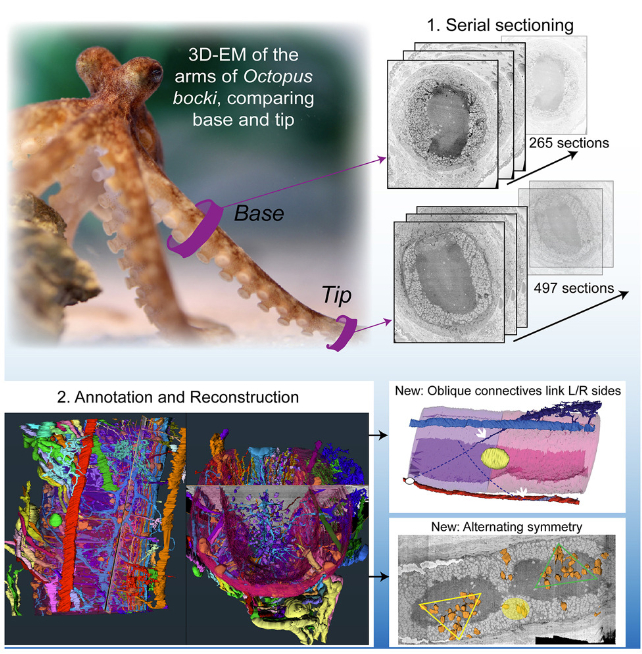In contrast with the arms of an octopus, our personal bony limbs are about as versatile as previous tree branches. It stands to cause that the anatomy throughout the cephalopod’s sucker-speckled appendages must be as distinctive because the animals themselves.
Mapping the weave of nerves and muscle groups inside octopus arms has till now been challenged by the sheer complexity of the duty, limiting research to accumulating two-dimensional slices and guessing at how they may sew collectively.
Now, two research from evolutionary biologist Robyn Criminal’s laboratory, at San Francisco State College, have revealed an unprecedented stage of element within the tissues of what some declare to be the closest factor to an alien on Earth.
“Having [these two papers] converging on the identical time means the quantity we will study from any single experiment is simply astronomically larger,” says Criminal.
“I’d say these papers are actually facilitating discovery in new methods.”
Watching an octopus seek for prey is like watching ink movement with function. Devoid of bones, its musculature warps, twists, extends, and reaches with a steadiness of energy and dexterity nearly unmatched within the animal kingdom.
Earlier research have offered a broad understanding of the interactions between indirect and longitudinal muscle groups, and the way tons of of hundreds of thousands of neurons collect in clusters, known as ganglions, to offer every arm its personal stage of management, like troopers in a well-disciplined unit, loyal to the trigger but able to particular person problem-solving.
However simply because the human mind is an online of various courses of neuron working underneath the path of all kinds of neurotransmitters, the nervous programs of octopus arms must have a stage of neurochemical group that permits them to maneuver, sense, and suppose with a level of autonomy.
Criminal and her staff undertook two separate investigations to reconstruct the preparations and classifications of nerves working down the arms of Bock’s pygmy octopus (Octopus bocki) specimens.
One experiment, led by neuroscientist Gabrielle C. Winters-Bostwick, used a type of DNA expertise to tag and establish distinct varieties of nerve cells. Taking high-resolution pictures of the arms from tip to high with a recently-acquired innovative microscope confirmed how every class of nerve cell was distributed in three dimensions, revealing distinctions of their populations all through the limb.
“This enables us to start out hypothesizing and posing new questions eager about how the cells talk with each other,” says Winters-Bostwick.
“It is mainly constructing our arsenal and our toolkit to raised perceive the habits and physiologies of octopuses.”
A second investigation, led by biologist Diana Neacsu, utilized electron microscopy to reconstruct the structure of neurons, muscle groups, and pores and skin, demonstrating how the completely different tissues join and relate.
The choice 3D map revealed shocking patterns within the animal’s cortex, indirect connections of the intramuscular nerve cords, repeated constructions containing nerve ganglions and blood vessels, which corresponded with sucker positions, and a curious association of uncommon, outsized nerve cells throughout the cell layers.

Having an atlas of octopus anatomy is only the start for studying how a mollusc behaves in such a relatable method, having adopted such a definite evolutionary pathway.
“Why do you will have an animal with this a lot complexity that does not appear to observe the identical guidelines as our different instance – people – of a really complicated nervous system?” says Criminal.
“There’s quite a lot of hypotheses. It is perhaps practical. There is perhaps one thing essentially completely different within the duties octopus arms must do. Nevertheless it may be an evolutionary accident.”
This analysis was printed in Present Biology right here and right here.





